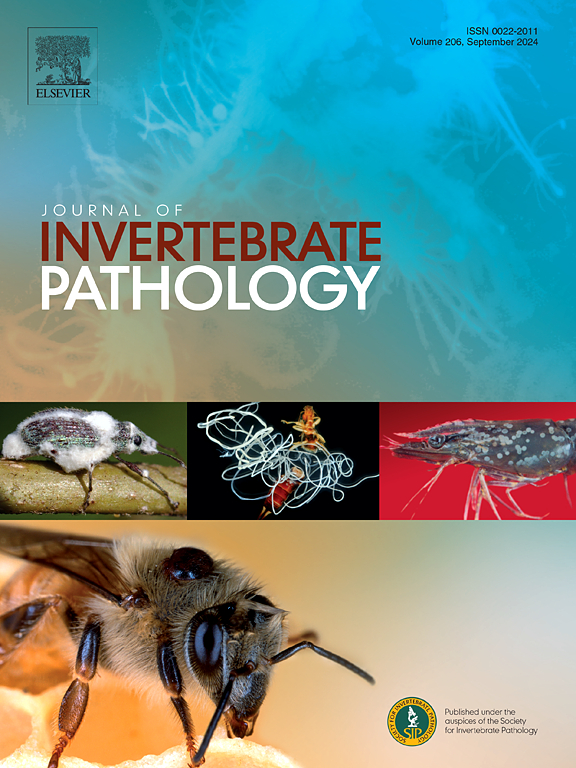Nanopore reads spanning the whole genome of arthropod-infecting large dsDNA viruses of the class Naldaviricetes enable assembly-free sequence analysis
IF 3.6
3区 生物学
Q1 ZOOLOGY
引用次数: 0
Abstract
The nuclear arthropod-specific large DNA viruses comprise different phylogenetically related virus families (Baculoviridae, Nudiviridae, Hytrosaviridae and Nimaviridae) forming the class Naldaviricetes. One common characteristic of their large double-stranded circularly and covalently closed DNA genomes is the size of up to hundreds of kilobase pairs, encoding up to hundreds of open reading frames. Until recently, analyzing such large viral dsDNA genomes was hampered by short read sequencing techniques, requiring bioinformatic assembly strategies to construct a consensus sequence as a descriptor of a population of haplotype sequences. The ideal aim for decoding large dsDNA genomes is an assembly-free method that allows the individual gnomes of a virus population to be sequenced in individual reads without fragmentation. Such full-length genome sequencing of single genome molecules is made possible by Nanopore sequencing, which is increasingly used to decode representatives of the Naldaviricetes. The present study discusses the impact of Nanopore sequencing on the characterization of viral NALDV populations. Full-length genome reads can be found in published sequence data from Bombyx mori nucleopolyhedrovirus (BmNPV; family Baculoviridae) and Oryctes rhinoceros nudivirus (OrNV; family Nudiviridae) isolates, providing insight into the future of deciphering populations of members of the order Lefavirales and class Naldaviricetes. Thirty years after the first sequencing of a baculovirus in 1994, a new era of sequencing of arthropod-infecting large dsDNA viruses has begun, which will allow assembly-free analysis of entire populations of large dsDNA viruses.

纳米孔读取跨越节肢动物感染纳尔达维菌纲的大型dsDNA病毒的整个基因组,使无组装序列分析成为可能。
核节肢动物特异性大DNA病毒包括不同的系统发育相关的病毒科(杆状病毒科、裸病毒科、水螅病毒科和尼米病毒科),形成了纳尔达维虫纲。它们的大双链环状共价封闭DNA基因组的一个共同特征是高达数百千碱基对的大小,编码多达数百个开放阅读框。直到最近,分析如此大的病毒dsDNA基因组受到短读测序技术的阻碍,需要生物信息学组装策略来构建一个一致的序列,作为单倍型序列群体的描述符。解码大型dsDNA基因组的理想目标是一种无装配的方法,这种方法允许在单个读段中对病毒种群的单个基因组进行测序,而不会出现片段。这种单基因组分子的全长基因组测序是通过纳米孔测序实现的,纳米孔测序越来越多地用于解码纳尔达维菌门的代表。本研究讨论了纳米孔测序对病毒NALDV群体特征的影响。家蚕核多角体病毒(Bombyx mori nuclear polyhedrovirus, BmNPV;杆状病毒科)和猴鼻病毒(OrNV;裸病毒科)分离株,为破译Lefavirales目和Naldaviricetes纲成员群体的未来提供了见解。在1994年杆状病毒首次测序30年后,节肢动物感染大型dsDNA病毒测序的新时代已经开始,这将允许对整个大型dsDNA病毒群体进行无组装分析。
本文章由计算机程序翻译,如有差异,请以英文原文为准。
求助全文
约1分钟内获得全文
求助全文
来源期刊
CiteScore
6.10
自引率
5.90%
发文量
94
审稿时长
1 months
期刊介绍:
The Journal of Invertebrate Pathology presents original research articles and notes on the induction and pathogenesis of diseases of invertebrates, including the suppression of diseases in beneficial species, and the use of diseases in controlling undesirable species. In addition, the journal publishes the results of physiological, morphological, genetic, immunological and ecological studies as related to the etiologic agents of diseases of invertebrates.
The Journal of Invertebrate Pathology is the adopted journal of the Society for Invertebrate Pathology, and is available to SIP members at a special reduced price.

 求助内容:
求助内容: 应助结果提醒方式:
应助结果提醒方式:


